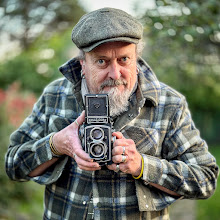
Just a bit of messing about to see what could be plonked on a sheet of 3'00" x 1'00". 'Carters' Siding was a clay pit off the truncated Corfe Mullen to Wimborne line on the former S&D, the route being severed in 1933.
The remaining 1 mile long siding from Corfe Mullen Junction served the clay pits until 1959, and then wagon storage until 1965 - the rails finally being lifted in 1968.
This quicky was knocked up in MS Paint, in reality it will be on a curve (which is rather beyond MS Paint). The truncated line ends on the left. The bridge on the right could be double track width with a new extra portal for the siding. The narrow gauge will be around 3 inches higher than the standard gauge siding on the ofreground.
In reality AFIK there was no loop, the loop here is just to jazz it up a tad. As I say, this is only a bit of armchair pontification (but so was Catcott)!
Update: Wednesday 31 Dec
Through photography eyes, the main gripe I have with this one is the double track +1 (for the siding which will be an additional 'later' portal) is that the cassette yard will be too visible through the bridge on the right. This common problem is noticed when photographing layouts - mirrors can take care of that for snaps but tend to get in the way of moving trains!
Since toying about yesterday, this has come to fruition of Carter's Siding (proper name was Corfe Mullen Siding) courtesy of that Google thing...http://www.trainweb.org/railwest/railco/sdjr/cmj.html#CMS
The siding was only long enough for 5 wagons which is great for us, but sadly no loop. If I wanted an accurate rendition, because the end of the line was to the left, trains had to run past, then shunt back into the siding - this means I'd need around 4 to 5 feet length which defeats the object of this project.
The siding was only long enough for 5 wagons which is great for us, but sadly no loop. If I wanted an accurate rendition, because the end of the line was to the left, trains had to run past, then shunt back into the siding - this means I'd need around 4 to 5 feet length which defeats the object of this project.
The sketch book is out again for some more armchair pontification, with this morning's below....
Another thought is a 3 foot module to join up to Catcott's right hand side (or stand alone using Catcott's fiddle yards) allowing trains to run right through, this time featuring the 'Eclipse Peat Works'. This could be interesting in that the narrow gauge feeder ran over the standard gauge http://www.sdjr.net/locations/ashcott.html , then over the canal which by this stage was on the opposite side of the line from Catcott over to a series of corrugated huts for the peat works. Narrow gauge wagons went up some kind of rickety wooden structure to load their content into wagons on the single standard gauge siding. Modelling something like this would be interesting too http://www.british-history.ac.uk/image.aspx?compid=15115&filename=fig57.gif&pubid=62
Whatever happens (if ever) presentation with be the usual black box 'house style' with built in lighting and curved backscene so as to blend in with existing projects...


















































